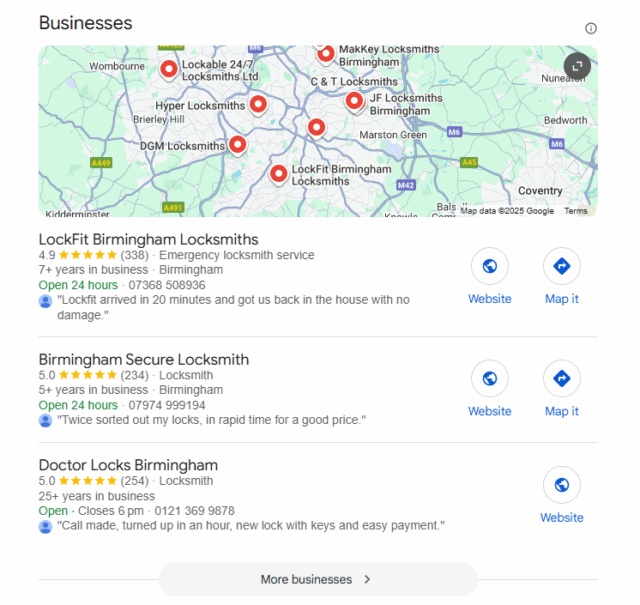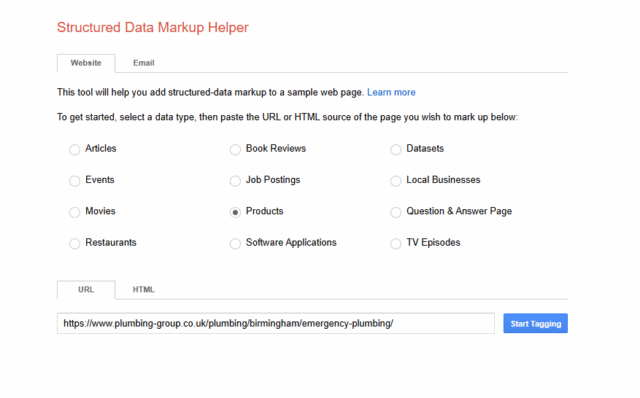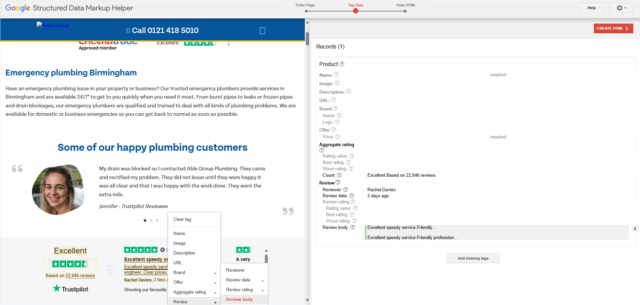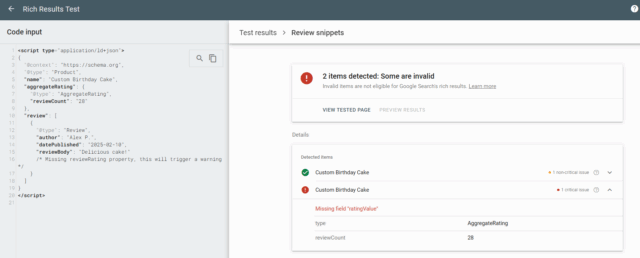
Can local businesses use review schema? Google’s rules explained
Last updated on October 14th, 2025
Schema markup is one of those topics that can feel like a cryptic language you need a decoder to understand.
At its core, schema is simply structured data that helps search engines understand what your pages are about. When implemented correctly, it can unlock eye-catching, rich results in Google, including star ratings, FAQs, and event listings.

One of the most common schema questions we hear from local marketers is:
“Can I use review schema for my local business?”
The short answer: sometimes, but with very strict rules.
In this guide, we’ll decode the guidelines around reviews schema, and walk you through how to implement it correctly. We’ll provide practical code examples, and alternative strategies for when review stars aren’t an option so you can confidently advise clients on whether review schema is right for them.
💡 Exploring schema beyond reviews? Grab our Local SEO Schema Templates
What is review schema?
Review schema (previously known as ‘reviews’ schema by Google) is a way of telling search engines about the reviews shown on your website. Schema is a type of structured data, that is, extra code you can add to a page to tell search engines about reviews and ratings. It provides clear information about:
- Who wrote the review
- What was reviewed, e.g., the product, service, book, course, or movie
- The rating or score given
- Optional details like the review date or a short description
When implemented correctly, review schema can show as rich results in Google, showing next to your website in search results or in the Knowledge Panel. These enhanced search results can include star ratings, review counts, and snippets from reviews.
But of course, as with all things Google, adding schema markup doesn’t guarantee rich results will show up.
Can you use review schema as a local business?
We understand why local business owners love star ratings in search results—they grab attention and build trust instantly. Unfortunately, for many local businesses, getting those stars to appear isn’t always possible.
In 2019, Google updated its review snippet guidelines and stopped showing “self-serving” review stars for LocalBusiness and Organization schema types. Google explained the change:
“Reviews that can be perceived as ‘self-serving’ aren’t in the best interest of users. We call reviews ‘self-serving’ when a review about entity A is placed on the website of entity A – either directly in their markup or via an embedded third-party widget. That’s why, with this change, we’re not going to display review-rich results anymore for the schema types LocalBusiness and Organization (and their subtypes) in cases when the entity being reviewed controls the reviews themselves.”
This means that even if you add LocalBusiness review markup to your website, it won’t generate the star ratings in Google search that business owners hope for. This is the case whether you add the reviews and schema yourself or embed a third-party widget pulling the reviews directly from review sites.
Playing it safe with schema
Schema can help your business stand out in search results, but using it incorrectly could cause big problems.
Google may take manual action if your structured data is misleading. This means your website could lose eligibility for rich results or even be removed from search results entirely. Google has an extensive list of structured data issues that could lead to manual actions.
If a manual action happens, Google will notify you in Search Console. Fix the issues and request a review to get your eligibility restored.
For LocalBusiness review schema specifically, you won’t usually face a penalty for mistakes, but Google simply won’t display rich review results, so adding it incorrectly can be a waste of time.
Using review schema for products and services
Even though LocalBusiness review schema won’t trigger star ratings in search, there is still a way for eligible local businesses to use review markup effectively and without breaking any rules.
The key is to focus on products or services offered by your business rather than the company as a whole. Google treats these as reviewable items, which means you can display review-rich results for them in search.
Products and Services share almost identical review properties in schema. The difference comes from Google’s side: Product reviews are explicitly supported and documented for review snippets in search results, while Service reviews are valid according to Schema.org but less directly highlighted in Google’s Search guidelines.
In practice, that means Product reviews are more reliably shown, whereas Service reviews may appear but aren’t guaranteed. Google could stop showing reviews for services like it did for local businesses at any moment, so don’t count on this being the case!
Product type
Product: Google explicitly supports review and aggregateRating markup for products, making them eligible for rich review snippets in search results. This is the most straightforward and well-documented use case. For example, a bakery could mark up its custom cake product, and a hardware store could markup its power drills for sale.
Service type
Service: A Service type represents work performed for customers, like a locksmith’s emergency lockout service, or a 1:1 personal training session at a gym. You can add aggregateRating and attach reviews to describe customer feedback on the service. Google can show review snippets here too, though support is less direct than with products.
It’s important to only add review schema to product or service pages that contain reviews. Avoid applying it on pages like your homepage where no real reviews exist. This ensures your markup remains accurate, compliant, and eligible for rich results.
Product and service schema properties
When building review schema, you’ll usually work with two key properties: Review and aggregateRating.
- Review is used to mark up details in individual customer reviews, like the reviewer’s name, the date posted, the review content, and the star rating.
- AggregateRating is used to show the overall score for a product or service, based on multiple reviews.
Property Sub-properties (examples) Definition
aggregateRating ratingValue, reviewCount, ratingCount, bestRating, worstRating The overall rating based on a collection of reviews or ratings.
Review author, datePublished, reviewBody, reviewRating
A single review of the service.
reviewRating ratingValue, bestRating, worstRating The rating given in an individual review (nested inside review).
Review stars in other places
While it’s not possible to use localBusiness schema on your website for reviews, it doesn’t mean stars will never show for your business in other places.
Business listing sites like Yelp are still eligible to show star ratings in search. For the best chance of your business’s stellar reputation being noticed, make sure you’ve claimed your listing on all the best general and niche sites. Search your keywords and see what potential customers may be seeing, then claim these listings—no code needed!

It’s important to note that review schema on your website does not affect your Google Business Profile (GBP). The reviews and star ratings that appear on your GBP are entirely controlled by Google and come from customer submissions on Google itself. Adding structured data to your site won’t affect the stars on your business profile, nor will it transfer your website reviews to Google.

How do you add schema?
Adding schema means using a type of code to explain your content to search engines by placing it in the <head>, <body>, or <footer> of a page. This will not be visible to visitors to your website.
You can do this with:
- JSON-LD: A block of JavaScript added in the <head> or <body> of the page. It’s easy to add and maintain, and it doesn’t affect page layout, and is preferred by Google.
- Microdata: Added directly into HTML elements. It works anywhere, but can be harder to manage since it mixes with page content
- RDFa: Also added in HTML attributes, but it is more complicated and less commonly used.
Generating review schema
If you’re savvy with code, create the schema yourself. If not, you can use a tool like Schema.Dev’s Schema Builder for Structured Data Chrome extension or Google’s Structured Data Markup Helper to build it for you. It’s simpler than you might think once you get your head around it, promise!
Choose your data type (likely Products if you’re looking to markup a product review), then add your page URL.

Highlight the section of the page you want to tag, and right-click to find the appropriate property (e.g., reviewer, review date, aggregateRating). Once you’ve marked up all relevant sections, click Create HTML to generate the structured data.

Adding and testing schema
Add this to the <head>, <body>, or <footer> code of the page (or ask your developer if you have one!)
It’s very important to test your code, as it’s really easy for mistakes to sneak in. Use Google’s Rich Results Test or Schema.org’s Schema Markup Validator to check the code or page URL for errors or warnings. The example below shows what happens if ‘reviewRating’ is missed inside the Review object.

Google may take some time to recognize the markup, so keep a close eye on Google Search Console for any structured data or warnings over the next few weeks.
Example reviews schema for products and services
So now we know when and how review schema can be used, let’s look at what it actually looks like in practice. Below are some simple JSON-LD examples you can copy and adapt for your own websites.
Example schema for products
<script type=”application/ld+json”>
{
“@context”: “https://schema.org”,
“@type”: “Product”,
“name”: “Custom Birthday Cake”,
“brand”: “Sweet Treats Bakery”,
“aggregateRating”: {
“@type”: “AggregateRating”,
“ratingValue”: “4.9”,
“reviewCount”: “28”,
“bestRating”: “5”,
“worstRating”: “1”
},
“review”: [
{
“@type”: “Review”,
“author”: “Alex P.”,
“datePublished”: “2025-02-10”,
“reviewBody”: “The cake was delicious and beautifully decorated. Highly recommend!”,
“reviewRating”: {
“@type”: “Rating”,
“ratingValue”: “5”,
“bestRating”: “5”,
“worstRating”: “1”
}
},
{
“@type”: “Review”,
“author”: “Samantha K.”,
“datePublished”: “2025-03-05”,
“reviewBody”: “Perfect cake for my birthday party. Everyone loved it!”,
“reviewRating”: {
“@type”: “Rating”,
“ratingValue”: “5”,
“bestRating”: “5”,
“worstRating”: “1”
}
}
]
}
</script>
Example schema for services
<script type=”application/ld+json”>
{
“@context”: “https://schema.org”,
“@type”: “Service”,
“name”: “Emergency Locksmith Service”,
“provider”: {
“@type”: “LocalBusiness”,
“name”: “Birmingham Locksmiths”,
“address”: {
“@type”: “PostalAddress”,
“streetAddress”: “123 High Street”,
“addressLocality”: “Birmingham”,
“postalCode”: “B1 2AB”,
“addressCountry”: “GB”
}
},
“aggregateRating”: {
“@type”: “AggregateRating”,
“ratingValue”: “4.8”,
“reviewCount”: “42”,
“bestRating”: “5”,
“worstRating”: “1”
},
“review”: [
{
“@type”: “Review”,
“author”: “Jane D.”,
“datePublished”: “2025-01-15”,
“reviewBody”: “Fast response and very professional. Got me back into my house in no time!”,
“reviewRating”: {
“@type”: “Rating”,
“ratingValue”: “5”,
“bestRating”: “5”,
“worstRating”: “1”
}
},
{
“@type”: “Review”,
“author”: “Mark L.”,
“datePublished”: “2025-02-20”,
“reviewBody”: “Very reliable service. Arrived quickly and fixed the lock efficiently.”,
“reviewRating”: {
“@type”: “Rating”,
“ratingValue”: “4”,
“bestRating”: “5”,
“worstRating”: “1”
}
}
]
}
</script>
What to do if you aren’t eligible for review schema?
If your business isn’t eligible for review schema under the LocalBusiness guidelines and doesn’t offer products or services with their own reviews, it’s time to accept that review stars won’t appear in search results. But this doesn’t mean your hard-earned reviews go to waste. Other platforms may still use structured data to understand your business, and there are a lot of schema types that you will be eligible for.
The key is to focus your efforts where you can make an impact. Mark up your address, contact information, opening hours, and frequently asked questions to help Google better understand your business. For a deeper dive, check out our full LocalBusiness schema guide.
Quick review schema rules to remember
✅ Allowed → Product/service reviews (may show stars).
⚠️ Allowed but ignored → LocalBusiness reviews (Google won’t show stars).
🚫 Risky → Fake / hidden/misattributed reviews (can trigger penalty).